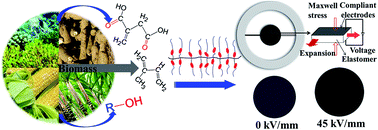A new dielectric elastomer with large actuated strain driven by low electric field was synthesized from di-n-butyl itaconate and isoprene through free radical redox emulsion polymerization. The effect of the copolymerized proportion of poly(di-n-butyl itaconate-co-isoprene) (PDBII) and the dosage of crosslinking agent on the elastic modulus, dielectric properties, and actuated strain of the elastomer were investigated, and a potential dielectric elastomer candidate containing 70 wt% di-n-butyl itaconate was obtained. The permittivity of the PDBII crosslinked by 3.0 phr of dicumyl peroxide was 5.68 at 103 Hz, which was higher than that of commercial acrylic and silicone dielectric elastomers. Without any prestrain, an actuated strain of 20% was obtained at an electric field of 30 kV mm−1. In order to further increase the actuated strain, barium titanate (BaTiO3), a high-dielectric-constant ceramic powder, was utilized to fill the PDBII to form a BaTiO3/PDBII composite. The dielectric constant of the composite increased with increasing content of BaTiO3, and the elastic modulus of the composite was lower than that of the unfilled PDBII, leading to a larger dielectric actuated strain of the composite.
